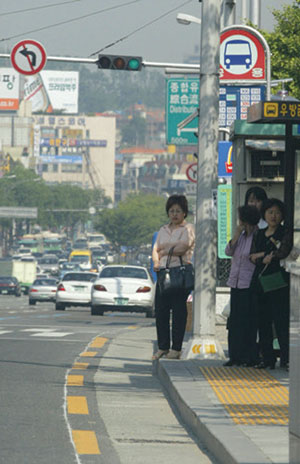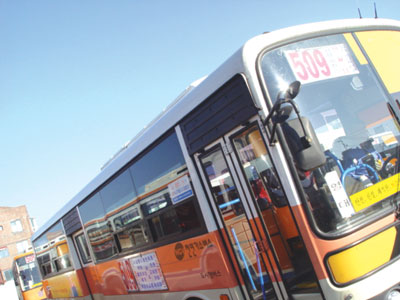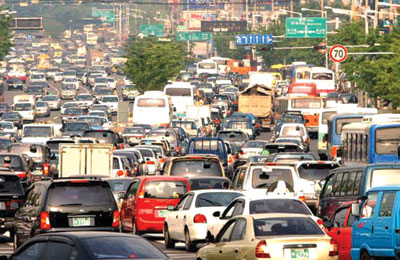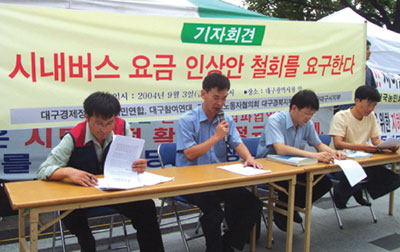
We have traffic card!! But...
Many Korean people use the public transportation system to get around the city where they live, and out of all the forms of public transportation, buses are the most popular form of transportation in Korea. Even if there is a subway system in their area, many Koreans will use their local bus system before using the subway. Taking the bus is economical and convenient, especially for people who have a traffic card. Buses in the Deagu and Gyeongbuk area have the option for passengers to use a traffic card. Recently, The Bus Association has vocalized that they want every passenger to start using traffic card. They are also planning to the put up the bus fare because of the implementation of a Quasi Joint Management Institution and because of the irrationality of the bus companies in Deagu.

In July 2001 there was a conference held for resolving this matter, but unfortunately Deagu said this request could not begiven permission because the Gyeongsan Bus Company had already set up a different traffic card machine called the Shinary traffic card. On July 9, 2004 Deagu city was planning to hold a conference about putting DaeGyeung bus machines onto Gyeongsan buses, but the conference did not happen.
What happened to this event?
During the strike, Deagu bus operation had very few buses on the road, therefore Deagu citizens had to use Gyeongsan buses. Gyeongsan buses didn't have DaeGyeung traffic card machines, so people had to pay seven hundred won, where as if people use a traffic card, the payment is only six hundred eighty won. People also had to wait for buses for over one hour because Gyeongsan had even fewer buses operating than Deagu. Therefore, if someone didn't have coins or a one thousand won bill, then they couldn't take the bus. It was very inconvenient and people requested that there be DaeGyeung traffic card machines on all buses in the Gyeongsan and Deagu area.
But Gyeongsan still does not have DaeGyeung traffic card machines on their buses. If DaeGyeung traffic card machines were installed onto Gyeongsan buses, then all the problems both citizens and the bus companies are facing would be quickly resolved. But, Deagu and Gyeongsan have differing opinions about installing DaeGyeung card machines on Gyeongsan buses because people will use Gyeongsan buses, and then, the profits will go to the Gyeongsan Bus Company instead of to Deagu. The Gyeongsan Bus Company however wants to be free to setup machines and make the extra profits that are currently going to Daegu. Gyeongsan Bus Company's opinion is that Deagu does not want them to have machines on their buses because fifty percent of the stockholders in the DaeGyeung traffic Card Company are members of the Deagu Bus Association, therefore DaeGyeung Bus Company stockholders are ruling the bus system and would lose money if Gyeongsan was to start receiving some of the profits due to the DaeGyeung card machines.
Presently, Gyeongsan Bus Company believes that setting-up DaeGyeung traffic card machines is the best solution for these problems. However as a countermeasure, Gyeongsan Bus Company was responsible for the eradication of the Cooperation Allocation of Vehicles Emperor (CAVE), which made many people unhappy. It also changed the bus numbers, and reduced the bus fee in order to set up DaeGyeung traffic card machines. Gyeongsan are no longer demanding anything. Deagu is raising the bus fee and they are not going to set up the DaeGyeung traffic card system for citizens because Gyeongsan is no longer demanding change.

Citizens have been waiting for a considerable amount of time to discuss the problems they are facing because of CABRS. What is CABRS? It is that different bus companies are working together on the same bus lines. There are three buses under CABRS in Daegu and Gyeongsan, the 840, the 509(a seat bus) and the 890.
We are looking at the beginning and development of CABRS. Three bus companies of Daegu and one bus company of Gyeungsan concluded an agreement about CABRS on the 27th of November 1982. A total of four bus companies balanced allocation of buses and all profits were divided. Today there are three kinds of CAVE buses in Daegu and Gyeongsan.
The bus companies in Daegu started using a DaeGyeong traffic card in November 2000, which has created friction between Daegu and Gyeongsan. Nine companies had arranged a meeting for July 9th of this year to discuss attaching DaeGyeung Card Reader machines to the Gyeongsan buses, but the meeting was cancelled because the Daegu Bus associations pulled out before the meeting.
After this event, on August 1, 2004, Gyeongsan refused to be a part of CABRS and accused them of holding Daegu's hand. Daegu and Gyeongsan citizens are dissatisfied that the DaeGyeong card is not read. The Gyeongsan bus company decided that they must change two points: First, they decided to charge discount bus fares. Secondly, they changed the bus numbers because they would not be using the same bus number as Daegu. Number 840 and 890 buses were changed to 800 and 509 buses were changed to 500.
What are the merits and demerits of CABRS? The one good point is in the case of CABRS, not just one bus company receives all the profits from bus transportation, but many companies must divide and balance the profits equally. There are some negative. First, bus drivers started to ignore the bus rules. For example, they began ignoring their scheduled leaving-time and pick-up times. Second, many bus companies have irregular finish times, so citizens don't know what time they can catch the last bus. Finally, CABRS works in association with several different companies, therefore, if a problem rises, no one knows who is responsible.

What is the solution to this problem concerning CABRS? In the case of Daegu and Gyoungsan, bus companies get more money from university area, JungAng Road and BanWolDang than other lines. When CAVE did not exist, all bus companies wanted these lines, so CABRS was born to allocate these routes fairly. Each bus company should not need to drive recklessly in order to fulfill their quota for the day.
"Gyeongsan and Daegu are in the same area. Therefore, citizens suffer a great inconvenience because each bus company uses a different traffic card. If Gyeongsan bus established DaeGyeong card reader machines then, we would have to increase the fare to be the same as Daegu and go back to using the same system that was used before CABRS was created." said the Vice-President of Gyeongsan Bus Company, Kim Jung-ung.
"Gyeongsan Bus has to come to a consensus with Daegu. No more citizens should experience inconvenience caused by establishing the DaeGyeong Traffic Card." said Jung Duk-su of Daegu City.
CABRS has ended because of the problem of mutual profit amongst all bus companies involved in the system. The problem of establishing DaeGyeong traffic card machines on Gyeongsan buses also helped to destroy CABRS. It has been a service for mutual benefits for about 20years, but Gyoungsan decided that they don't live together with Daegu. Gyeungsan bus has given inconvenience and confusion to both Daegu and Gyeungsan people by initiating the abrogation of CABRS and changing its bus numbers.
A Quasi Joint Management Institution and Increasing of Bus Fare
A Quasi Joint Management Institution is a system whereby a Joint Management Agency earns all of a bus company's profits, and when the bus companies show a loss, a Joint Management Agency fills the deficit. On the contrary, when bus companies are in the black, a Joint Management Agency invests in the foundation of the bus company. Last May, the Daegu Bus Association asked Daegu city to enforce this system with a demand for higher wages. The government of Daegu city could not comply with their request owing to the lack of money in their budget. However, a few days later, the government of Daegu City decided to meet this demand because of a bus drivers strike. The government of Daegu City determined to raise the fare to 900 won in order to secure a budget for carrying out a Quasi Joint Management Institution.

The Daegu city government has presented solutions for these problems. First, the Daegu city government has recommend that traffic cards should be used to clarify bus company profits. When citizens use a card to pay their bus fare, the Daegu city government has promised to give a 100 won discount. Second, a Quasi Joint Management Institution will solve the bus service route problem. If this occurs, all bus routes by law will be done at regular intervals. Therefore, citizens can conveniently use the bus service.
However, some citizen organizations have raised the question whether a Quasi Joint Management Institution is truly good for citizens. Bus companies are already supported with about 200 hundred million won by the government of the city each year. When the government bears the loss of the bus company within a Quasi Joint Management Institution, bus companies will not make an effort to decrease their loss or improve their service. If this occurs, bus companies will face further problems.
Buses are the only form of transportation for many people. Therefore, citizens need to take a stand. Civil power asserted through citizen organizations and university students can solve these problems. Bus companies actually wanted to increase the bus charge by 200 won in 2000, but then decided to only increase the bus charge by 100 won because of the objection of university students and citizen organizations. Therefore, we can solve these problems through active expression.
bus number is Zero

Reporter Nam Sang-me / tkdalggu@yumail.ac.kr Reporter Jung Jin-a / angelbada77@yumail.ac.kr
Reporter Son Jung-a / wsysja@yumail.ac.kr


